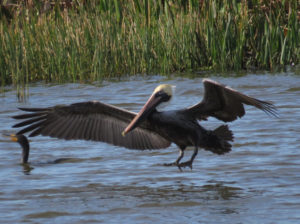There’s not a cloud in the sky – fairly typical for a morning at the Coquina, located in the Siesta Bay Resort Community in Fort Myers, Florida, especially during the winter months.
Christmas is less than a week away. But if it wasn’t for the decorations on people’s houses, in their yards, and even on their golf carts, you wouldn’t know it. The only white Christmas you’ll find here is on almost any one of the nearby beaches.
At about 10 a.m., it’s sunny, 70 degrees, with a little breeze from the south – southwest Florida at its finest.
Ann and I are into birds and shells. Birds more so on my part, shells more so on Ann’s part. This morning, it’s all about the birds.
First on the list must be the seemingly ever-present fish crows. Right now, sitting in front of the Coquina, I can see about 20 of them along the shore of Swan Lake, one of two lakes in the Siesta Bay community. I can hear another dozen or so. Their call is not what most would call a pleasant sound, but it screams “Florida” to me.

For the last ten minutes, that’s about all that’s been happening. That will change. It’s Florida. Birds are just about everywhere.
In fact, if I get up from my chair and take two steps to see around our neighbor’s car, two white ibises pop into view. Talk about a common bird here – white ibises are all over the place, even the Wal-Mart and Lowe’s parking lots.
Yesterday, I took part in the Christmas Bird Count on Sanibel Island. My area to cover was about a fourth of the Ding Darling National Wildlife Refuge. In two hours, I tallied 283 white ibises, not all of which were white.

Immature white ibises are splotched with a few shades of brown making many people think they’re a separate species. They’re not. They’re simply younger birds. Their feathers will be all white next year.
A whole flock of fish crows just flushed from the shoreline, trees, and shrubs on the far side of Swan Lake. Too many to count individually, but I’d estimate between 120 and 140 birds. The 20 or so I could see from my chair were clearly part of a much larger group.
Fish crows may be dominating the soundscape right now, but a Brown Pelican just stole the visual aspect of the show flying over at a height of only about 30 feet.

Soaring well above him (her?), a Turkey Vulture glides effortlessly on the morning’s breeze.
Just as he disappears to the south, a Black Vulture heads the other way. Black and turkey vultures are in the same family as the California Condor. Some people have a little trouble discerning between the black and turkey vultures, but there are a few things to look for that will help you make an unerring identification every time.


There are more differences than just where the lighter feathers are located on the wings. Black vultures are smaller, have considerably shorter tails, and less head projection. Turkey vultures tend to fly with the tips of the wings a little higher than the body of the bird; black vultures tend to hold their wings flat.
Three more turkey vultures head generally west. A couple of minutes later, four more.
A lone White Ibis heads northeast.
A new star for the show appears from the north — an American White Pelican. It slowly circled over Swan Lake before coming down on the water in the southwest corner of the lake, the corner farthest from me … of course.

One, two, four, five — no, wait — four double-crested cormorants come up for air. The fifth bird near them is not a cormorant, but an Anhinga. These are two more species that some may have difficulty with.


Several other differences between anhingas and cormorants are apparent in the images above.
Even in flight you can easily tell them apart. Anhingas – flap, flap, flap, glide – flap, flap, flap, glide. Cormorants seem to constantly flap and almost never glide unless they are coming in for a landing.
Clouds, although wispy and high, are beginning to roll in from the west. Rain is expected tonight. It comes every 3 or 4 days this time of year, Generally, though, it’s only enough to water the outside plants, if that.
Then a new day will dawn. Will the bird activity be the same as today? Doubtful. How will it be different? Does it really matter?
We only have our memories and the here and now.
I, for one, am happy with both on this Coquina Sunday Morning.
